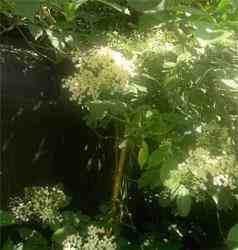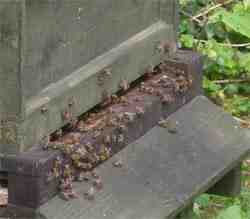Fiona’s traditional elderflower cordial recipe
Posted by Fiona Nevile in Cordials and Syrups | 181 comments
Photo: Elderflower blossoms in the sun - best picked for cordial
It’s elderflower cordial recipe season once again!
Yesterday afternoon I found myself up a tall ladder with a carrier bag, picking elderflower heads. I picked about fifty heads. They are best picked when the sun is on them. I climbed higher and higher to find exactly what I wanted. They had to be perfect with no trace of brown blossom. According to Joanna’s Food brown blossom can foul the cordial.
My sister brought a similar recipe back from France. Since I introduced Danny to elderflower and pink grapefruit cocktail, it seemed a good idea to make my own cordial tweaking the recipe to suit my taste.
There is a printable recipe card below the post!
There seem to be as many uses for elderflower cordial as recipes. Apart from adding a splash to fruit fools and pies, it can be added to a vinaigrette dressing, and apparently is delicious with chicken breasts. Determined to experiment I made double the quantity below. I poured my cordial into warm sterilised bottles and sealed them immediately with corks. They keep well in a cold area of the barn – we often are finishing the last bottle of cordial as the new flowers open on the trees. I also freeze some syrup, just in case.
Other elderflower recipes that my interest you:
Fiona’s Elderflower and Lemon cordial
Judy’s Elderflower and Lime Jellies
Fiona’s Elderflower and Raspberry Jellies
| Fiona’s traditional elderflower cordial recipe |
- 1.5 litres of boiling water
- 1 kilo of white granulated sugar
- 20 large elderflower heads (if they are small, pick more)
- 4 lemons
- 55g of citric acid
- In a Pyrex bowl (or deep saucepan) pour the boiling water onto the sugar and stir. Leave to cool, stirring every now and then to dissolve the sugar.
- When cool add the citric acid, the lemons (zested and sliced) and the elderflower heads.
- Leave to steep for 48 hours.
- Strain twice through sterilised muslin (how do I sterilise muslin? See Tips and tricks below)
- Using a jug and funnel carefully pour into hot sterilised bottles (how do I sterilise bottles? See Tips and tricks below)
Tips and tricks:
How do I sterilise a jelly bag or muslin square?
Both can be scalded with boiling water. If you are using a clean muslin bag or square you can iron them with a hot iron. This also works with tea cloths.
How do I sterilise bottles?
The sterilising method that we used is simple. Just before making the syrup, I quickly wash and rinse the bottles and place them upside down in a cold oven. Set the temperature to 160c (140c fan-assisted). When the oven has reached the right temperature I turn off the heat. The bottles will stay warm for quite a while. Sterilise the lids by boiling these for a few minutes in water.
Leave a reply






Ginger beer makers – a word of warning! Having made 5 bottles of non-alcoholic ginger beer – I asked a friend if she would mind putting them in her cool garage for 2 weeks as we have no space in our tiny cottage. For reasons only known to her, she and her husband decided to store them in their kitchen larder instead. These were new plastic bottles, not glass, with new screw-tight tops and what do you know? Two exploded 6 days later, totally destroying the plastic bin they were next to and distributing the contents throughout her newly decorated kitchen. Oops. The scary thing was that her 7 year old son had just walked past the open larder a minute before they went up and could have been hurt as shards of plastic went everywhere. Yes, they had noticed the bottles swelling, but no, they had not released the gas. Ho hum. Guess there goes my lashings of ginger beer days!
Hi Dianne
Great that our recipe worked out well for you! Thanks for leaving a comment.
Another thank you. I have masses of elderflowers in my Devon garden and used your recipe to make cordial (and made good use of the tips other people have posted). Had a first tasting tonight and it was fantastic. Am particularly grateful for the info re plastic bottles and elderflower champagne (I’d made a bucket of that too!) I’d ordered some Grolsch type beer bottles but they haven’t arrived so will now be using a stack of water bottles instead.
Hi Mich
Thanks for dropping by and leaving these brilliant tips!
Thanks for all the tips on this page – I’ve made cordial (I have a recipe that includes some root ginger and limes as well as lemon and it’s gorgeous) and some champagne this year, but found the cordial very quickly started to get fizzy when left out on the windowsill. Freezing in ice cube trays sounds like a great solution.
As for champagne – I’ve always had a lot of success using plastic bottles. One useful tip – if you squeeze the plastic bottles as you fill them with the champagne, so the bottles are slightly deformed, the gases in the champagne will have more room to spread out. The bottle expands back to its normal shape as the champagne gets fizzy, and it’s less likely to explode!
(Having said that I always wrap mine up in old plastic bags or newspapers when I store them, just in case…)
Hi Ruth
The bottles staying squidgy dowsn’t sound right to me. I have never frozen cordial in bottles so wouldn’t know what to expect. It might be worth investigating further.
Hi Laurie
Thanks so much for sharing your experience and tips about making elderflower cordial. Excellent – really useful stuff.
Thanks for this great recipe. Here are a few things i found usefull to know.
1) the high sugar content will prevent fermentation as long as you put enough in. If it ferments you probably didnt have enough sugar.
2) the citric acid is to prevent it going mouldy, most chemists have to order it in as it is used by junkies for something horrible. You dont need it if you are meticuously sterile in your preperation and bottling.
3) We all found it very sweet so used loads more heads so we could dilute it more and still get the flavour.
Another tip is to buy cheap bottled water, you can use this to make your liquer and as the bottles are already sterile you can just bottle it straight back into the empties. If you fill them to the very top they should not mould and you can check to see if they are fermenting by looking for gas in the top of the sealed bottles, if there is, freeze the suckers.
Oh , and a slice of root ginger in the bottle is awesome too!
Hi,
I made my first batch of cordial the other day and put half of it in the freezer in plastic bottles for later in the year. It hasn’t frozen solid but has stayed soft and squidgy – is that normal?
Enjoying the rest of it – fantastic!!
Hi Rosie
Thanks for dropping by and apologies for the belated response. I’m up to my eyes at the moment.
Great that you have made cordial. It’s so much better than the stuff from the shops! Hope that the mix turned out well.
Hi Claire
I’m not sure whether you should use more heads with the pink elderflowers. My gut reaction is to say yes as it’s the essence that you are capturing. White flowers rely on their smell to attract insects, coloured flowers depend more on their colour.
I am no expert but I definitely would use more of the pink heads, you need your nose to guide you. When it smalls right, you probably have the right amount. If you can make white champagne alongside the pink it would be easier to get the ratio right.
I’d love to hear how you get on!
Hi All,
Have just made cordial and 2 batches of champagne – one of which was with pink elderflowers. They dont seem as aromatic as the white flowers – does anyone know if I should use more heads? Have plenty of time – living in Yorkshire we still have many heads yet to flower and the pink elderflower will probably go on for another 2 weeks!